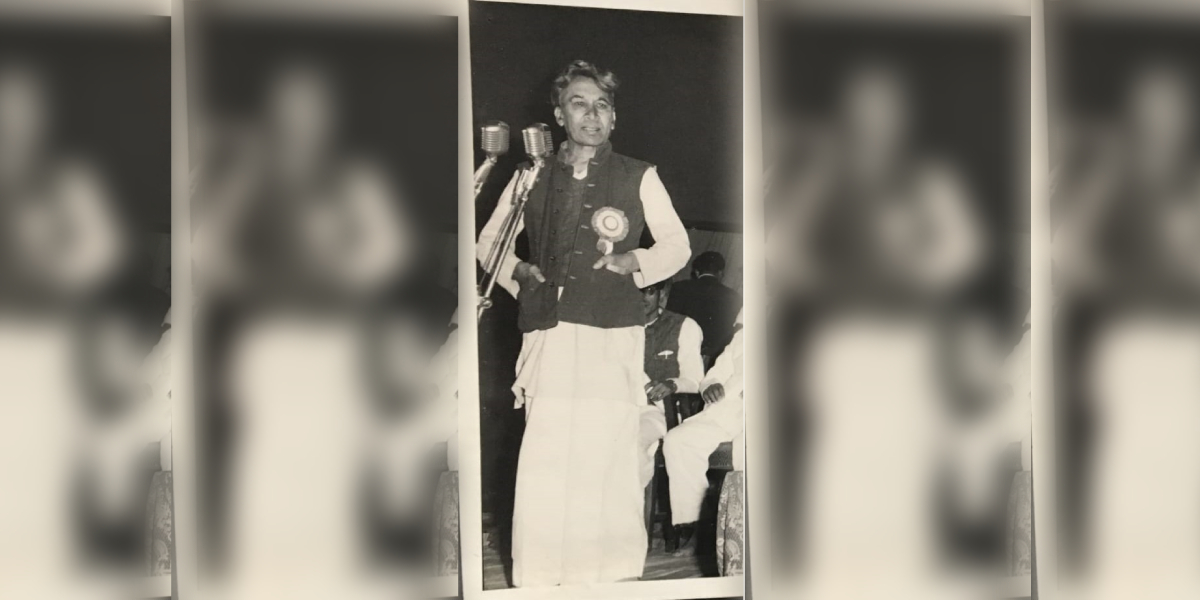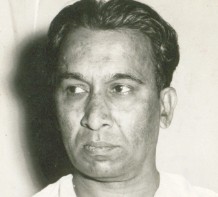On the 115th birth anniversary of AN Krishnarao (better known as Anakru), Dr Mythri Bhat introduces us to 'the uncrowned king of the Kannada nove' in an essay woven around Anakru's famous novel, 'Sandhyaaraaga'.

Anakru speaking at the Kannada Sahitya Sammelana held in Manipal in 1960 (Kannada Sahitya Parishattu)
“Compassionate humanity is the only way to prevent the world from exploding; the poet is the prophet of such humanity.” The same man also said, “There are several people like me for Kannada; but I have only one Kannada,” and used his works to lift the veil that covered society’s shortcomings and to expose its truths.
The name of the man was Arakalagudu Narasinghrao Krishnarao, better known to the Kannada people as ಅನಕೃ or ‘Anakru’. Anakru, whose ancestral home was Arakalagudu in the Hassan district, was born on 9 May 1908 in Kolar to Narasingharao and Annapoornamma.

A b/w profile of Anakru (Book Brahma)
Anakru’s writing style, in which he uses his characters to explore the different aspects of life, is intimate by itself; it becomes even more intimate and fulfilling by imbuing readers with a love and zest for life.
Anakru’s knowledge of the world and his outlook on life were unusual. His talent for narrative, his prose style, his choice of subject, and his language were all people-facing.
Piquantly, Anakru began his literary journey in response to a challenge put to him by the theatre actor, Varadacharya, by writing the play ‘ಮದುವೆಯೋ ಮನೆಹಾಳೋ (Maduveyo Manehalo)’ in one night! Going on to make writing his livelihood, Anakru created a literary output that runs to over 80,000 pages.
His first novel was ‘Jeevanayaatre’. Subsequently, Anakru produced one novel after another in a seemingly unending stream, making writing his career by doing so.
By virtue of his output, his experimentation, and the various subjects he tackled, Anakru influenced a whole generation of writers even as he made the novel the primary medium of expression in 20th-century Kannada literature.
Through the humanism in his works, Anakru attempted to increase the dignity of the life of the common man.
The loosening effect that the pressures that modern life was causing on traditional practices, the ups and downs of family life, sexual matters, the world of art and artists, and the ills of society — Anakru depicted all these in his novels. He also wrote cutting essays about the state of Karnataka’s politics and economic affairs at the time.
Famously known as the ‘the emperor of the Kannada novel’, we see Anakru’s depiction of a changing society, village life, and the dissolution of the undivided family in his novels.
We also see him offering a critique of the culture of the land, describing the traditional mindset and the tragic plight of women in a society in flux.
When the novels he wrote about sexual matters and prostitution caused a stir in the literary world of his time and he was criticised by both traditionalists and progressives for it, Anakru defended himself by writing an unusual book titled ‘Saahitya Mattu Kama Prachodane (Literature and Titillation)’.
Anakru began a monthly magazine called ‘Kathanjali’ that was dedicated to short stories.
As the pioneer of the progressive movement in literature and as the progenitor of new writers with a new outlook, Anakru’s prose style and knack for dialogue are especially attractive to the reader. His ability to depict the many faces of life, the subjects he chose to write about, and his talent for narrative beguiled thousands of readers.
The book ‘Bhaarateeya Chitrakaleyalli Raja Ravivarmana Sthaana (Raja Ravi Varma’s Place in Indian Art)’, published in 1932, was the first work of art criticism in Kannada.
In his lifetime, Anakru wrote a total of 72 short stories, collected in the volumes, ‘Agnikanye’, ‘Kidi’, ‘Minchu’, ‘Paapapunya’, ‘Kamana Solu’, ‘Kannumucchale’, ‘Shilpi’, and ‘Samarasundari’.
His famous short stories are ‘Annada Koogu’, ‘Nanna Muddu Saroja’, ‘Avala Baalu’, ‘Savitriya Soubhagya’, and ‘Madhura Svapna’.
The novel ‘Sandhyaargaaga’ was responsible for making a writer of Beechi, Kannada’s famous humorist, by instilling a sense of pride in him for the Kannada language.
The novel is singular for how it makes its characters representatives of human values even as it piques the reader’s interest. Though this novel tells the story of a family, like the title suggests, the theme of the novel is music-driven.
In the novel, the life of a musician is narrated as a melding of raga (melody), tala (rhythm), and pallavi (refrain). Though the protagonist, Lakshmana, is not academically inclined, music is his life. He says in that novel that “no matter the kind of knowledge, if we are to gain it, our mind must expand, our curiosity must be piqued. The pursuit of that knowledge should become a single-minded purpose. It is only then that one attains success”.
This attitude of rising above one’s worldly problems and troubles and keeping one’s mind fixed on reaching the heights of one’s sadhana (dedicated hard work) is what the novel examines.
The possession of knowledge but an inability to act with wisdom or discrimination becomes the reason for the downfall of the older brother, Ramachandra. “A mind without blemish, honest effort, and the determination to achieve something” – these three qualities are together sufficient to achieve success is what the novel emphasises.
The novel also contains depictions of the village life of those times, the importance that used to be given to relationships, the reciprocal intimacy of such relationships, the respect and generosity that used to be shown towards the arts, and the details of family and society. The details in these depictions have been discussed with affectionate concern.
In Srinivasa’s character, we see a depiction of how imitating the ways of somebody one admires can help mould one’s own personality. Srinivasa tries to live his life in the manner of Karna, the man he admires.
His arrival in Bengaluru from the village and his attempt to adapt to his new surroundings appear to be an indication of how “life, like a river, is constantly in motion and in flux”. Through Gopala’s character, Anakru seems to exhibit a distaste for our education system that moulds all students in the same manner, regardless of individual interest.
Says Gopala about the education system, “It is akin to the creation of a certain type of brick using a mould; the work of pouring hot liquid.”
By placing a number of other characters around the central musician character, Anakru attempts to explore the difference between an artist and a ‘regular’ person. In his attempt, he concludes that an artist sees and interacts differently with the world than a regular person does.
“One does not think of sadhana (dedicated hard work) as something that has been fully done or finished; one looks to reach something that is beyond it. That said, not everything can be expressed through art.” Here, Anakru is offering his own perspective on life and art through his character’s thoughts.
By describing the samskara (accumulated character) of many lives as “moments of our lives that we devote to art”, Anakru looks at the idea of the fruit of past lives in a new light. He also says, through the character of Lakshmana, that “music is not something that comes easily; it requires unceasing hard work”.
If a person takes up art as a means of satisfaction, the art too develops through the medium of the person. As a whole, the novel discusses the difference in the fundamental character as well as interests of people from the same background (and who have the same roots) and suggests that, education aside, love, patience, and a quality of humanity are what give meaning to life.
Anakru’s stance about overcoming an infatuation for using other languages and advocacy for the use of the Kannada language in (classical Karnatak) music is testament to his pride in and affection for Kannada.
In addition to its ability to create a sense of enveloping peace, music is also capable of stimulating the subconscious mind. “To awaken with clarity from sleep and to step into a new world is what ‘life awareness’ really means” is an invaluable insight offered by the novel. All in all, ‘Sandhyaaraaga’ is an unprecedented and especially valuable addition to Kannada literature.
Anakru passed away on 7 July 1971. A naturally gifted writer, his writing life spanned more than four decades, during which he produced stories, novels, plays, biographies, and books of criticism and made an indelible name for himself in Kannada literature.
(This article is a translation by Madhav Ajjampur of a Kannada essay by Dr Maithri Bhat. Dr Maithri has an MA in Kannada and an MSc and PhD in Psychology. She is currently living in Vitla and working as a Kannada lecturer in Vivekananda University, Puttur. Her first poetry collection, ‘Antaragada Hejje’ was published in 2017 with monetary assistance from the Kannada Pustaka Pradhikara.)

Apr 25, 2024

Apr 25, 2024

Apr 24, 2024

Apr 24, 2024

Apr 24, 2024

Apr 24, 2024